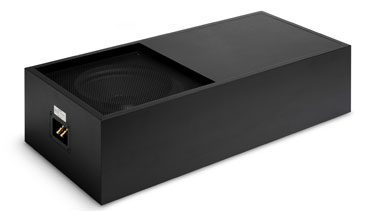Review: Velodyne SC-600 Subwoofers and SC-602 Amp Page 2

Velodyne packages the SC-602 with your choice of two SC-600 IW (in-wall) or two SC-600 IF/IC (in-floor/in-ceiling) subwoofers. The former has dual 6[1/2]-inch woofers and dual passive radiators. The latter has a single 12-inch woofer. Both are no-frills black boxes designed for building into walls then drywalling over. Both packages list for $1,699.
SETUP
The company supplied me with the SC-600 IF/IC option, which is a great choice for many installations. Each sub measures 32 x 14 x 9 inches, so it fits between standard floor or ceiling joists. The long, slim design will also work great in installations that hide the speakers behind a fabric "wall," and I bet it would also work well in a custom-built cabinet. I didn't cut the dual subs into my ceiling, but I got the same acoustical effect by placing them on the floor in the front corners of my room.
The separate amplifier will make installation easy and potentially less expensive because the amp plugs into the same AC power strip that powers your other components, and any custom installer or consumer can run the speaker cables from the amp to the subs. (Powered subs occasionally require calling in an electrician to install the necessary AC outlets, and running line-level cable through the walls to your powered subs is usually more difficult than running speaker cables.) The only unusual step in setting up the SC-602 is that you have to configure it using the front-panel display for the type of subs you're using: in-wall, in-ceiling, in-floor, or a generic model.
EQ'ing the subs was as easy as Velodyne promised. However, measurements using my own calibrated microphone and a PC running True RTA software revealed that the EQ function isn't particularly powerful. It can optimize performance only for one listening seat; unlike, say, Audyssey MultEQ, it doesn't allow you to move the microphone to several positions so you can get the best averaged response for several listeners. Also, the SC-602 applies the same EQ curve to both subwoofers, which can work, but theoretically it'd be more efficient and effective to apply a different EQ to each sub, letting one do most of the work while the other sub fills in the gaps, so to speak.
Years of measuring and listening in my room have taught me that its most prominent acoustical characteristic is a broad, roughly [1/3]-octave-wide peak of about +6 dB, centered at 40 Hz (measured from the center of my couch). The SC-602's auto EQ did nothing to soften this peak; all it did on the first try was to kick up the range from about 20 to 28 Hz by a couple dB.
To be fair, the bass I got when listening to the two corner-placed subs was relatively even, according to my ears and to True RTA, so there wasn't that much for the EQ to do in the first place. To give the auto EQ a tougher test, I chose a ridiculous listening position much closer to a wall, and put the subs in the kinds of illogical places that someone who doesn't know the first thing about audio would choose. Here, the auto EQ was a little more aggressive, pulling down the most prominent peak by about 3 dB. I was able to do much better using the manual adjustments available on Velodyne's standalone SMS-1 sub equalizer, but that unit lists for $749 - almost half the price of the whole SC-600 system.
Later, one of Velodyne's engineers told me that the auto EQ has a maximum boost or cut of ±3 dB, a consciously limited range chosen with the Hippocratic goal of "First, do no harm." For an automatic system, especially, that's a wise decision, because if you have a cancellation (or "suckout") at a certain bass frequency, pumping more energy into it won't fix it - and could easily burn out your subs. Also, with only five bands of EQ to work with, the auto EQ's limited resolution allows some response errors to fall through the cracks.













































